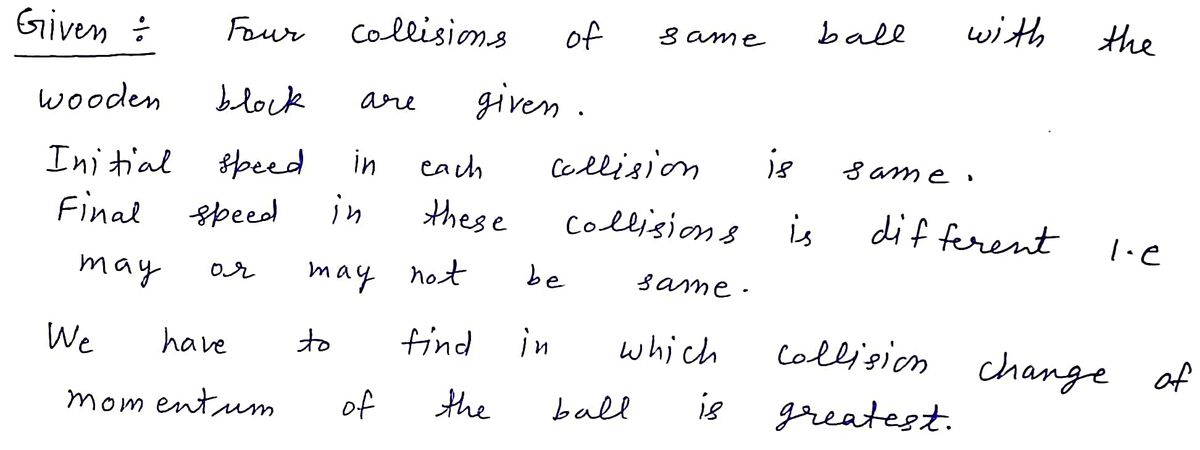The figure below shows four diagrams (labeled A through D) of a collision between a ball (shown in black) and a block of wood (shown in tan). Each diagram shows the situation before and after the collision. In each collision the same ball approaches the block of wood from the left. The initial speed of the ball (the speed of the ball before the collision) was the same in each collision. Assume air resistance and other sources of friction are negligible in all cases. The collision happens quickly enough that the effect of gravity on the ball can be ignored as well. Before After (same speed) B Before After (same speed) Before After (stopped) Before After (slower) In collision A, the ball hit the block of wood and bounced back to the left with the same speed. The initial and final velocities were both perpendicular to the surface of the block. In collision B, the ball hit the block with a velocity that was not perpendicular to the surface of the block. The ball bounced back to the left with a velocity that made the same angle with the surface of the block. The initial and final speeds of the ball were the same as in collision A. In collision C, the ball it the block and lost all of its speed, thus dropping to the base of the block of wood (and remaining there at rest). In collision D, the ball knocked the block down and the ball continued to the right at a reduced speed. Again, the initial speed of the ball was the same in each collision. In which collision, A through D. was the magnitude of the change in momentum of the ball the greatest?
The figure below shows four diagrams (labeled A through D) of a collision between a ball (shown in black) and a block of wood (shown in tan). Each diagram shows the situation before and after the collision. In each collision the same ball approaches the block of wood from the left. The initial speed of the ball (the speed of the ball before the collision) was the same in each collision. Assume air resistance and other sources of friction are negligible in all cases. The collision happens quickly enough that the effect of gravity on the ball can be ignored as well. Before After (same speed) B Before After (same speed) Before After (stopped) Before After (slower) In collision A, the ball hit the block of wood and bounced back to the left with the same speed. The initial and final velocities were both perpendicular to the surface of the block. In collision B, the ball hit the block with a velocity that was not perpendicular to the surface of the block. The ball bounced back to the left with a velocity that made the same angle with the surface of the block. The initial and final speeds of the ball were the same as in collision A. In collision C, the ball it the block and lost all of its speed, thus dropping to the base of the block of wood (and remaining there at rest). In collision D, the ball knocked the block down and the ball continued to the right at a reduced speed. Again, the initial speed of the ball was the same in each collision. In which collision, A through D. was the magnitude of the change in momentum of the ball the greatest?
Related questions
Question

Transcribed Image Text:The figure below shows four diagrams (labeled A through D) of a collision between a ball (shown in black) and a
block of wood (shown in tan). Each diagram shows the situation before and after the collision.
In each collision the same ball approaches the block of wood from the left. The initial speed of the ball (the speed
of the ball before the collision) was the same in each collision. Assume air resistance and other sources of friction
are negligible in all cases. The collision happens quickly enough that the effect of gravity on the ball can be
ignored as well.
Before
After
(same speed)
B
Before
After
(same speed)
Before
After
(stopped)
Before
After
(slower)
In collision A, the ball hit the block of wood and bounced back to the left with the same speed. The initial and
final velocities were both perpendicular to the surface of the block.
In collision B, the ball hit the block with a velocity that was not perpendicular to the surface of the block. The
ball bounced back to the left with a velocity that made the same angle with the surface of the block. The initial
and final speeds of the ball were the same as in collision A.
In collision C, the ball it the block and lost all of its speed, thus dropping to the base of the block of wood (and
remaining there at rest).
In collision D, the ball knocked the block down and the ball continued to the right at a reduced speed.
Again, the initial speed of the ball was the same in each collision.
In which collision, A through D. was the magnitude of the change in momentum of the ball the greatest?
O tis impossible to know without more information.
OD
O A
B
Expert Solution
Step 1

Trending now
This is a popular solution!
Step by step
Solved in 4 steps with 4 images
